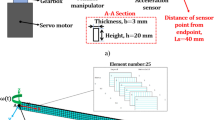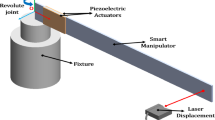Abstract
The increasing demand for high-speed performance and low energy consumption has necessitated the design of lightweight mechanical systems. The active vibration suppression of a flexible manipulator is important in many engineering applications, such as robot manipulators and high-speed flexible mechanisms, because the flexibility of lightweight manipulators induces a vibration problem. Frequently, the optimal parameters determined for a certain control algorithm might not cover a wide range of operating conditions. Hence, we have proposed and developed a lookup table control method for a flexible manipulator that can tune itself to optimal parameters on the basis of the initial maximum responses of the controlled system and a genetic algorithm. The genetic algorithm is used to search for optimal parameters with regard to positive position feedback and thereby minimizes the objective functions determined from the initial maximum responses. Our lookup table, which has the optimal parameters of the positive position feedback as a function of the initial maximum responses, can be used in a real-time control algorithm.
Similar content being viewed by others
References
S. K. Dwivedy and P. Eberhard, “Dynamic analysis of flexible manipulators, a literature review,” Mechanism and Machine Theory, vol. 4, pp. 749–777, 2006.
J. Shan, H. T. Liu, and D. Sun, “Slewing and vibration control of a single-link flexible manipulator by positive position feedback (PPF),” Mechantronics, vol. 15, pp. 487–503, 2005.
Y.-G. Tang, F.-C. Sun, Z.-Q. Sun, and T.-L. Hu, “Tip position control of a flexible-link manipulator with neural networks,” International Journal of Control, Automation, and Systems, vol. 4, no. 3, pp. 308–317, 2006.
V. Feliu, K. S. Rattan, and H. B. Brown, “Adaptive control of single-link flexible manipulator,” IEEE Control Systems Magazine, vol. 10, no. 2, pp. 29–33, February 1990.
M. Bodson, “Experimental comparison of two input shaping methods for the control of resonant systems,” Proc. of IFAC World Congress, San Francisco, CA, 1996.
J. M. Hyde and W. P. Seering, “Using input command pre-shaping to suppress multiple mode vibration,” Proc. of IEEE International Conference on Robotics and Automation, Sacramento, CA, vol. 3, pp. 2604–2609, 1991.
P. H. Meckl and W. P. Seering, “Experimental evaluation of shaped inputs to reduce vibration for a Cartesian robot,” J. Dyn. Syst. Meas. Control, vol. 112, pp. 159–165, 1990.
F. Khorrami, S. Jain, and A. Tzes, “Experiments on rigid bodybased controllers with input preshaping for a two-link flexible manipulator,” IEEE Trans. on Robotics and Automation, vol. 10, pp. 55–65, 1994.
F. L. Lewis, S. Jagannathan, and A. Yesildirek, Neural Network Control of Robot Manipulators and Nonlinear Systems, Taylor and Francis, UK, 1999.
T. Ravichandran, G. K. H. Pang, and D. Wang, “Robust H1 optimal control of a single flexible link,” Control-Theory and Advanced Technology, vol. 9, no. 4, pp. 887–908, 1993.
H.-J. Lee, S.-W. Kau, Y.-S. Liu, C.-H. Fang, J.-L. Chen, M.-H. Tsai, and L. Lee, “An improvement on robust H∞ control for uncertain continuous-time descriptor systems,” International Journal of Control, Automation, and Systems, vol. 4, no. 3, pp. 271–280, 2006.
C. J. Damaren, “Adaptive control of flexible manipulators carrying large uncertain payloads,” Journal of Robotic Systems, vol. 13, pp. 219–228, 1996.
M. K. Kwak, H. Seok, and G. J. Jin, “Adaptive positive position feedback controller design for the vibration suppression of smart structures,” Proc. of the 9th SPIE Conference on International Symposium on Smart Structures & Materials, Seattle, July 2002.
M. McEver and D. J. Leo, “Autonomous vibration suppression using on-line pole-zero identification,” Journal of Vibration and Acoustics, pp. 487–495, 2001.
K. J. Yoon, J. S. Shin, H. C. Park, and N. S. Goo, “Design and manufacture of a lightweight piezo-composite actuator,” Smart Materials and Structures, vol. 11, pp. 163–168, 2002.
K. J. Yoon, K. H. park, N. S. Goo, and H. C. Park, “Analytical design model for a piezo-composite unimorph actuator and its verification using lightweight piezo-composite curved actuators,” Smart Materials and Structures, vol. 13, pp. 459–467, 2004.
K. Y. Kim, N. S. Goo, H. C. Park, and K. J. Yoon, “Performance evaluation of lightweight piezo-composite actuators,” Sensors and Actuators, vol. A120, pp. 123–129, 2005.
M. Landong, S. Heo, and N. S. Goo, “Application of a LIPCA for the structural vibration suppression of an aluminum cantilever beam with a tip mass,” Journal of Mechanical Science and Technology, vol. 21, pp. 919–923, 2007.
S. Arief, N. S. Goo, and H. C. Park, “Use of light weight piezo-composite actuators to suppress the active vibration of an aluminum beam,” Journal of Intelligent Material Systems and Structures, vol. 19, no. 1, pp. 101–112, 2008.
R. R. Craig, Structural Dynamics, Wiley, NY, 1981.
J. S. Arora, Introduction to Optimum Design, Elsevier, 2004.
Author information
Authors and Affiliations
Corresponding author
Additional information
Recommended by Editorial Board member Hyoukryeol Choi under the direction of Editor Jae-Bok Song. This work was supported by the Korea Research Foundation under grant KRF 2006-005-J03302 and the Korea Science and Engineering Foundation under grant KOSEF R0A-2007-000-20012-0.
Van Phuoc Phan received the BS (2006) from the Department of Aeronautical Engineering, HCM University of Technology, Vietnam. Currently, he is a Master student at the Department of Advanced Technology Fusion, Konkuk University in Seoul, Korea. His interests are structural dynamics of small systems, smart structure and material, and finite element analysis.
Nam Seo Goo graduated from the Department of Aeronautics Engineering of Seoul National University with honors in 1990, and got master and Ph.D. degrees in Department of Aerospace Engineering at the same university in 1992 and 1996, respectively. His Ph.D. degree was on the structural dynamics of aerospace systems. As soon as he got a Ph.D. degree, he entered the agency for defense development as a Senior Researcher. After four years’ service, he joined Department of Aerospace Engineering in Konkuk University, Seoul, Korea in 2002, currently serving an Associate Professor of Department of Advanced Technology Fusion. His current research interests are structural dynamics of small systems, smart structure and material, and MEMS applications.
Hoon Cheol Park received his BS (1985) and MS(1987) degrees from Seoul National University in Seoul, Korea and Ph.D.(1994) degree from the University of Maryland at College Park, MD, USA. He joined the Department of Aerospace Engineering, Konkuk University in Seoul, Korea in 1995, and he is currently a Professor in the Department of Advanced Technology Fusion. His professional experience includes Kia Motors (1986–1988) and Korea Aerospace Research Institute (1994–1995). His specialty is the finite element analysis and recent research topic is mainly biomimetics.
Rights and permissions
About this article
Cite this article
Phan, V.P., Goo, N.S. & Park, H.C. Vibration suppression of a flexible robot manipulator with a lightweight piezo-composite actuator. Int. J. Control Autom. Syst. 7, 243–251 (2009). https://doi.org/10.1007/s12555-009-0210-z
Received:
Revised:
Accepted:
Published:
Issue Date:
DOI: https://doi.org/10.1007/s12555-009-0210-z




